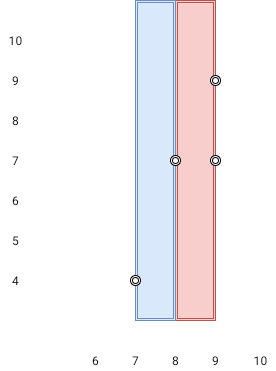- {x}
- Slowest Key
- Arithmetic Subarrays
- Path With Minimum Effort
- Rank Transform of a Matrix
- Percentage of Users Attended a Contest
- Add Two Polynomials Represented as Linked Lists
- Hopper Company Queries I
- Sort Array by Increasing Frequency
- Widest Vertical Area Between Two Points Containing No Points
- Count Substrings That Differ by One Character
- Number of Ways to Form a Target String Given a Dictionary
- Check Array Formation Through Concatenation
- Count Sorted Vowel Strings
- Furthest Building You Can Reach
- Kth Smallest Instructions
- Lowest Common Ancestor of a Binary Tree II
- Hopper Company Queries II
- Read More...

Widest Vertical Area Between Two Points Containing No Points
Given n points on a 2D plane where points[i] = [xi, yi], Return the widest vertical area between two points such that no points are inside the area.
A vertical area is an area of fixed-width extending infinitely along the y-axis (i.e., infinite height). The widest vertical area is the one with the maximum width.
Note that points on the edge of a vertical area are not considered included in the area.
Example 1:

Input: points = [[8,7],[9,9],[7,4],[9,7]] Output: 1 Explanation: Both the red and the blue area are optimal.
Example 2:
Input: points = [[3,1],[9,0],[1,0],[1,4],[5,3],[8,8]] Output: 3
Constraints:
n == points.length2 <= n <= 105points[i].length == 20 <= xi, yi <= 109
Solution Explanation
This problem asks to find the widest vertical area between two points in a given set of points, such that no other points are within this area. A vertical area is defined by its width, extending infinitely in the y-direction.
The most efficient solution involves sorting and a linear scan.
Approach:
-
Sort by X-coordinate: The crucial step is to sort the points based on their x-coordinates. This allows for efficient calculation of the widest vertical area.
-
Linear Scan: After sorting, iterate through the sorted points. The widest vertical area will always be found between consecutive points because if there was a wider gap further apart, there would be an even wider gap between consecutive points closer together. Calculate the difference in x-coordinates between consecutive points. The maximum difference found during this iteration represents the widest vertical area without containing any points.
Time Complexity Analysis:
- Sorting: The
sort()operation dominates the time complexity, taking O(N log N) time, where N is the number of points. - Linear Scan: The subsequent linear scan takes O(N) time.
Therefore, the overall time complexity is O(N log N), which is determined by the sorting step.
Space Complexity Analysis:
The space complexity depends on the sorting algorithm used. In-place sorting algorithms (like some implementations of mergesort) would have a space complexity of O(1) (constant space). Other algorithms may require O(N) space for temporary storage. Considering that the output is a single integer, the space complexity is considered O(1) for the in-place versions, O(N) otherwise.
Code Explanation (Python):
from itertools import pairwise
class Solution:
def maxWidthOfVerticalArea(self, points: List[List[int]]) -> int:
points.sort() # Sort points by x-coordinate
max_width = 0
for (x1, _), (x2, _) in pairwise(points): # Iterate through consecutive points using pairwise
max_width = max(max_width, x2 - x1) # Find the max difference
return max_widthThe pairwise function from itertools efficiently provides pairs of consecutive elements, making the code more concise. Other languages may not have a direct equivalent, so you would loop with points[i+1][0] - points[i][0]
The other language solutions achieve the same functionality; they differ only in their syntax and specific sorting methods used. The core idea of sorting and then iterating to find the maximum difference between adjacent points remains constant across all implementations.